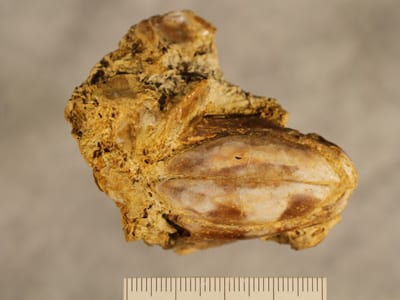A professional paleontologist has identified a new species of coelacanth from 100 million-year-old fossil remains found in the fossil-rich Duck Creek Formation, Texas.
The coelacanth research of SMU paleontology doctoral student John Graf has been covered by the Sci-News.com web site. Graf identified a new species of coelacanth from fossil fish bones discovered in Texas.
Watch a video about the new fossil, “100 million-year-old coelacanth discovered in Texas is new fish species from Cretaceous.”
Graf identified the fish from a 100 million-year-old skull fossil. He named the new species Reidus hilli. Graf said the new coelacanth is the first found in the Dallas-Fort Worth area. Discovered in the Duck Creek Formation, the fossil dates to the Cretaceous, making it the youngest coelacanth discovered in Texas.
EXCERPT:
Sci-News.com
“Coelacanth fossils have been found on every continent except Antarctica. Few have been found in Texas,” said John Graf of Southern Methodist University in Dallas, author of a paper reporting the discovery in the Historical Biology: An International Journal of Paleobiology. “These animals have one of the longest lineages of any vertebrates that we know.”“The specimen is the first coelacanth in Texas from the Cretaceous,” Graf said. “The Cretaceous geologic period extended from 146 million years ago to 66 million years ago.”
The paleontologist named the new species Reidus hilli for Robert T. Hill, a geologist with the US Geological Survey who led surveys of Texas during the 1800s. Hill described much of the geology of Texas, including the Duck Creek Formation. Hill is acclaimed as the “Father of Texas Geology.”
R. hilli is now the youngest coelacanth identified in Texas, previously the youngest was a 200 million-year-old coelacanth from the Triassic.
The specimen came from the Duck Creek Formation, which is a layer-cake band of limestone and shale about 40 feet thick. “The fossil was found in marine sediments,” Graf said. “It is one of many marine fossils found in the North Texas area, which 100 million years ago was covered by the Western Interior Seaway that divided North America from the Gulf of Mexico to the Arctic Ocean.”
Follow SMU Research on Twitter, @smuresearch.
For more SMU research see www.smuresearch.com.
SMU is a nationally ranked private university in Dallas founded 100 years ago. Today, SMU enrolls nearly 11,000 students who benefit from the academic opportunities and international reach of seven degree-granting schools. For more information, www.smu.edu.
SMU has an uplink facility located on campus for live TV, radio, or online interviews. To speak with an SMU expert or book an SMU guest in the studio, call SMU News & Communications at 214-768-7650.



 Academic achievement improved among students active in structured after-school programs
Academic achievement improved among students active in structured after-school programs New study on kingship and sainthood in Islam offers a striking new historical perspective
New study on kingship and sainthood in Islam offers a striking new historical perspective Texas frontier scientists who uncovered state’s fossil history had role in epic Bone Wars
Texas frontier scientists who uncovered state’s fossil history had role in epic Bone Wars